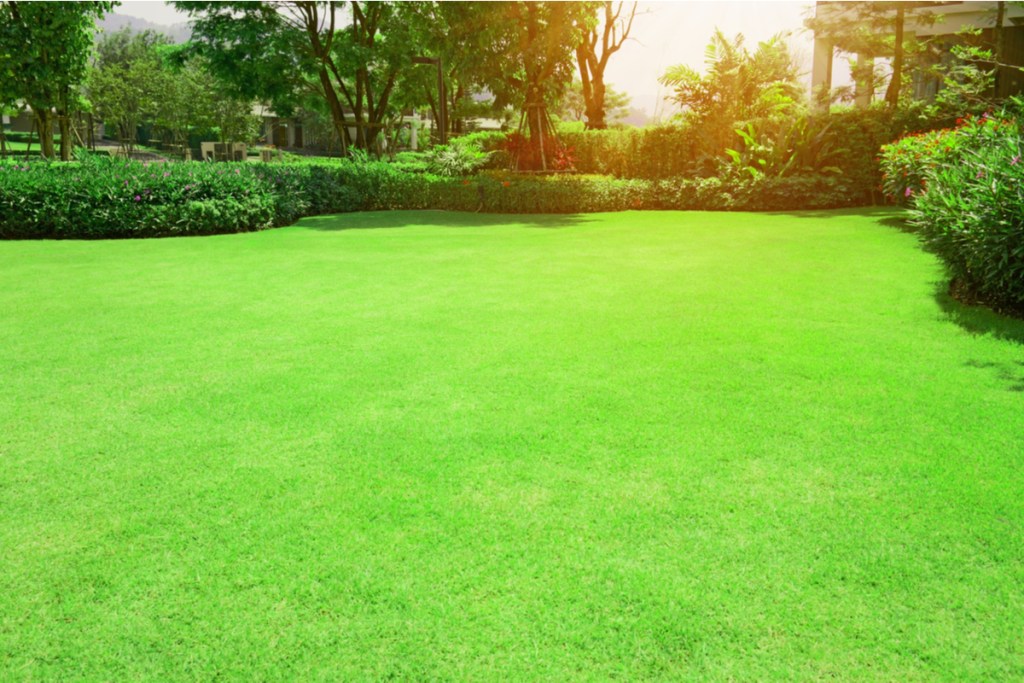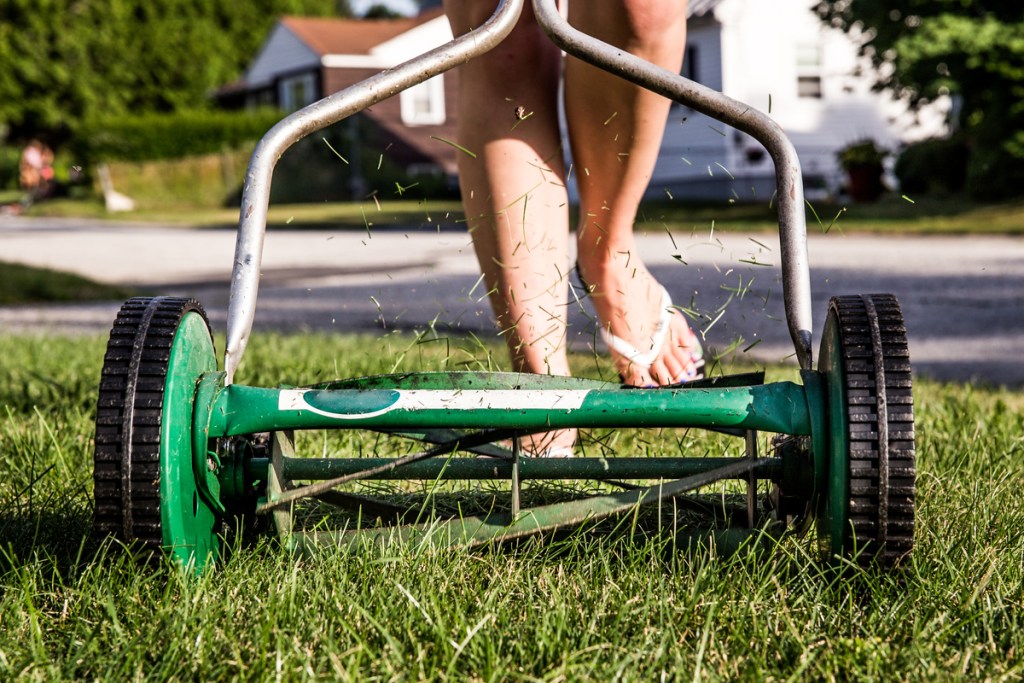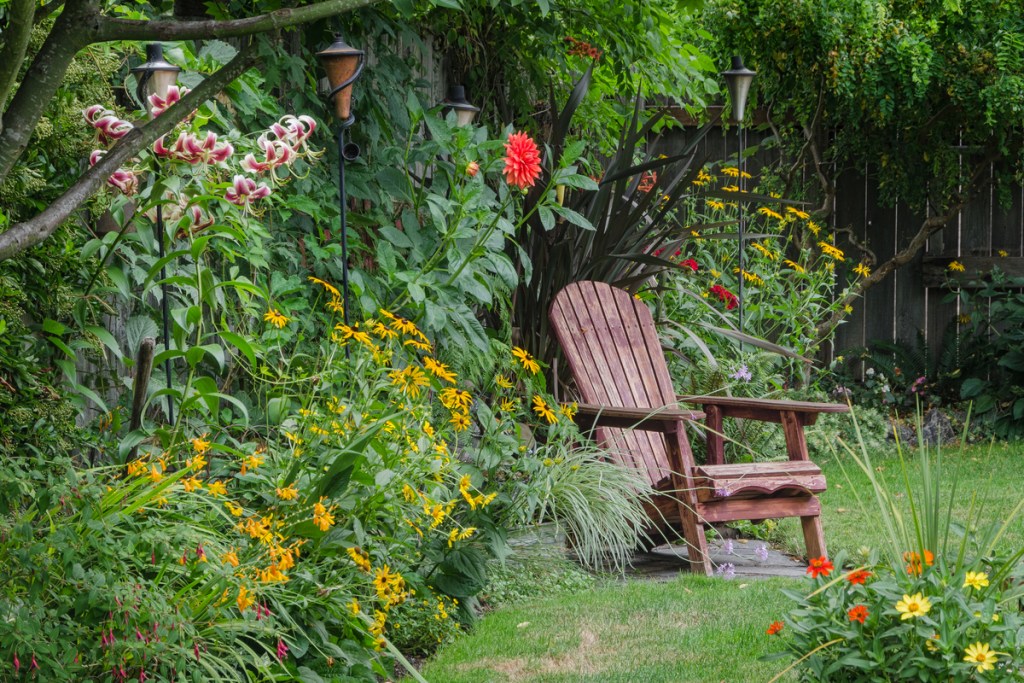
Having an attractive and functional yard is important, but drought is a concern. Lawn grasses need an average of one to 1.5 inches of weekly rainfall throughout the growing season. But even in favorable climates, grass is regularly faced with summer drought conditions that can cause damage or die back. Drought-proofing the lawn is possible with a combination of regular maintenance practices and drought response techniques. This is how it’s done.
Plant drought-tolerant grass
Grasses are classified as either warm season or cool season types. Warm season varieties grow best in mild climates with long, hot summers, like the southern, southeastern, and Gulf Coast regions in the United States. Cool season grasses perform well where temperatures fluctuate widely, with mild to hot summers and frigid winters, as seen in the northern, northeastern, midwestern, and Pacific Northwest regions.
Drought-tolerant, cool season grasses
Turf type tall fescue, fine fescue, and Kentucky bluegrass are the most drought tolerant of the cool season grasses. Fescues are popular in the transition zone between the midwest and the south, due to their wide temperature tolerance, and because they stay green through winter (unlike warm season grasses). Kentucky bluegrass is a bit less drought tolerant than fescue, and will go dormant during the driest times. But, unlike clumping fescue grass, it spreads via underground rhizomes to repair drought damage quickly when favorable weather returns.
Drought tolerant warm season grasses
Bermuda, centipede, and zoysia lawns are well adapted to hot temperatures and moderate drought. Once they’re well established, these grasses rarely need to be watered. In cases of extreme drought, healthy warm season grasses enter dormancy and turn brown. They may appear dead, but when the moisture returns, these tough lawns will green up again.

Establish a healthy lawn
Healthy lawns are well positioned to withstand drought. Deep roots, good fertility, and good mowing habits make a world of difference.
Water wisely
Grass grows best with an average of one to 1.5 inches of water each week. In much of the country, rainfall is typically adequate to supply these needs. Healthy lawns easily tolerate two weeks or longer without rain, but there are two important times to plan for supplemental watering: when planting new grass, and during extended dry spells.
New grass seed or sod should be watered daily during the month-long establishment phase. Watering should be light and frequent at first, gradually adjusting to more water less frequently. The goal is to train young roots to grow deeply so they can access the soil’s natural moisture reserve, instead of staying near the surface and relying on irrigation.
Avoid watering during times of normal precipitation. Grass does not need it. But if the rain dries up for a week or more, irrigate just enough to keep the grass alive and green—two or three times per week. Water early in the morning while the dew is still on the grass to minimize evaporation. Apply up to a half inch of water each time.
Mow the right way
Maintain the lawn at an appropriate height for the species and time of year. Mow as little as possible, but frequently enough to remove no more than 30 percent of the height at each cutting. For instance, if you keep the grass two inches high, it should be mowed when it is about 2.75 inches high. Cut it a bit higher than normal during times of fast growth, extreme heat, or drought.
Aerate the soil
Heavy soil sometimes becomes compacted due to traffic or wet weather. Compaction kills off some of the deep feeder roots, reducing drought tolerance. Monitor the soil for compaction and aerate when necessary to break up the compacted areas.
To properly aerate the lawn, use a core aerator, also called a plug aerator, when the ground is deeply moist but not saturated. The aerator will pull up plugs of soil, effectively pruning grass roots and turning the upper one to 1.5 inches of the soil into a sponge. This action stimulates new root development and allows improved gas exchange for a healthier root zone. Leave the soil plugs on the surface to dissolve back into the surface.
Treat with mycorrhizae
Mycorrhizae is a category of beneficial fungi that partners with plant roots for improved water access and nutrient efficiency. The fungus extends the reach of the grass roots by up to 30 percent. While mycorrhizae is naturally occurring in most soils, it normally becomes depleted with grading and construction of new homes. You can easily add it to the soil after aerating your lawn.
Purchase a broad spectrum mycorrhizal fungi product. Aerate the lawn during the active growing season, preferably in spring or fall. Spread the dry product immediately after aerating and water thoroughly to move the spores into the root zone.
Maintain fertility
Good plant nutrition helps the lawn resist the stress of drought. Soil pH and nutrient load affect longterm grass health, including root development and the lawn’s ability to photosynthesize. Availability of potassium in particular is linked to improved drought tolerance.
While grass is not a heavy feeder, and recycling clippings back into the lawn minimizes the need for added fertilizers, an annual fertilizer application in early summer is beneficial for most yards. Also, be sure to test the pH at least once per year. If the soil is too acidic, add lime to raise the pH.
Weeds and mixed grass lawns
Those who practice a “mow whatever grows” lawn care routine will notice that weeds and plants other than lawn grass proliferate when drought sets in. That is because of different adaptations to the changing conditions. Many annual weeds quickly develop robust root systems that allow them to out-compete lawn grass for the limited available water. Drought-tolerant grasses, on the other hand, enter a state of stress-induced dormancy.
Unless a tightly groomed appearance is important to you or your HOA, it’s fine to let nature run its course. Continue to mow whatever grows and the lawn will remain in a state of multicultural ebb and flow with changing weather patterns. Grasses that spread via self-healing rhizomes will come back to the fore when the weather improves. Clumping grasses will need to be reseeded.

Adjust lawn maintenance during drought
If the lawn is healthy when drought conditions set in, it should be well positioned to withstand the stress until the rain comes back. After a week or so without rain, it’s time to make a few changes that will help to moderate the impact that dry weather will have on your yard.
Minimize traffic
As the grass blades dry out, avoid walking on the yard whenever possible. Footprints on dry, crispy grass will remain visible. Of course some areas may be unavoidable, especially if you have children or pets. That’s okay, but know that these areas will be most susceptible to damage.
Increase mower height
In hot, dry weather, taller grass acts as a living mulch to help conserve soil moisture. The grass will continue to grow in dry weather, but slowly. There may be an increase in weed growth as grass slows down. Continue mowing to keep weeds from going to seed.
Decrease mowing frequency
Letting the grass grow taller means mowing less often. Mowing less also reduces traffic that can damage the brittle grass plants. Mowing monthly may be adequate to keep weed growth in check.
Discontinue fertilization
Grass only utilizes nutrients when it’s actively growing. Applying fertilizer during drought is a waste of money at best, and can damage the lawn as well. If you have not yet fertilized and drought conditions have set in, don’t worry. The grass is better off without it at this time.
Discontinue weed control
In the best of times, weed killers apply subtle stress on lawn grass. When drought conditions are added to the mix, problems increase significantly, up to and including die back. It’s best not to apply chemicals to the lawn while the grass is in a state of drought response.
Start (or stop) watering
When rains come regularly, there is no need to run the sprinklers. When rainfall becomes more intermittent, irrigation is a useful tool for filling in the gaps. This would include normal summer dry spells when rains are spaced out by a week or so.
But when there’s no rain at all, it becomes difficult and cost prohibitive to apply adequate water to keep the grass green. In these more extreme circumstances, for example when there has been no rain for three weeks and none is in the forecast, it’s best to stop watering. The lawn will be better off if it’s allowed to enter drought dormancy as a protection against drought damage.
Follow these steps, and you’ll be well on your way to an attractive, drought-proof lawn.
Editors' Recommendations
- Do you live in climate zone 10? Here’s our guide to choosing the perfect climate zone 10 plants
- A guide to winter lawn fertilizer for keeping your turf healthy this season
- 4 outdoor gardening projects to focus on this November
- Here are the best flowers and vegetables to plant in October
- The best vegetables to plant in October




